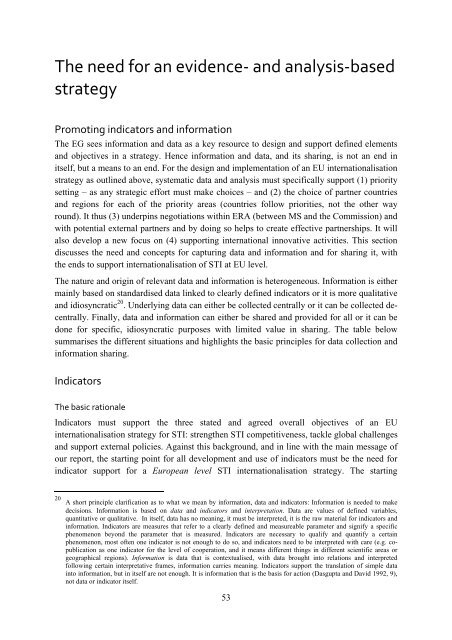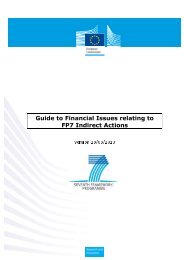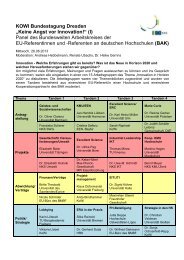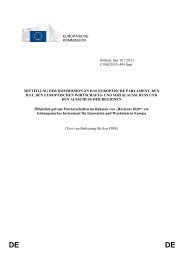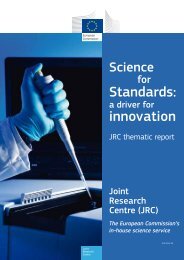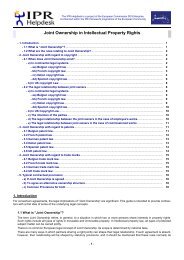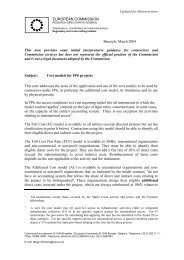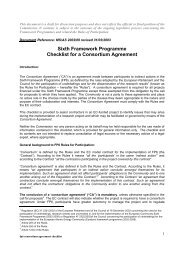Draft Report of the Expert Group on International STI Cooperation to ...
Draft Report of the Expert Group on International STI Cooperation to ...
Draft Report of the Expert Group on International STI Cooperation to ...
Create successful ePaper yourself
Turn your PDF publications into a flip-book with our unique Google optimized e-Paper software.
The need for an evidence- and analysis-based<br />
strategy<br />
Promoting indica<strong>to</strong>rs and informati<strong>on</strong><br />
The EG sees informati<strong>on</strong> and data as a key resource <strong>to</strong> design and support defined elements<br />
and objectives in a strategy. Hence informati<strong>on</strong> and data, and its sharing, is not an end in<br />
itself, but a means <strong>to</strong> an end. For <str<strong>on</strong>g>the</str<strong>on</strong>g> design and implementati<strong>on</strong> <str<strong>on</strong>g>of</str<strong>on</strong>g> an EU internati<strong>on</strong>alisati<strong>on</strong><br />
strategy as outlined above, systematic data and analysis must specifically support (1) priority<br />
setting – as any strategic effort must make choices – and (2) <str<strong>on</strong>g>the</str<strong>on</strong>g> choice <str<strong>on</strong>g>of</str<strong>on</strong>g> partner countries<br />
and regi<strong>on</strong>s for each <str<strong>on</strong>g>of</str<strong>on</strong>g> <str<strong>on</strong>g>the</str<strong>on</strong>g> priority areas (countries follow priorities, not <str<strong>on</strong>g>the</str<strong>on</strong>g> o<str<strong>on</strong>g>the</str<strong>on</strong>g>r way<br />
round). It thus (3) underpins negotiati<strong>on</strong>s within ERA (between MS and <str<strong>on</strong>g>the</str<strong>on</strong>g> Commissi<strong>on</strong>) and<br />
with potential external partners and by doing so helps <strong>to</strong> create effective partnerships. It will<br />
also develop a new focus <strong>on</strong> (4) supporting internati<strong>on</strong>al innovative activities. This secti<strong>on</strong><br />
discusses <str<strong>on</strong>g>the</str<strong>on</strong>g> need and c<strong>on</strong>cepts for capturing data and informati<strong>on</strong> and for sharing it, with<br />
<str<strong>on</strong>g>the</str<strong>on</strong>g> ends <strong>to</strong> support internati<strong>on</strong>alisati<strong>on</strong> <str<strong>on</strong>g>of</str<strong>on</strong>g> <strong>STI</strong> at EU level.<br />
The nature and origin <str<strong>on</strong>g>of</str<strong>on</strong>g> relevant data and informati<strong>on</strong> is heterogeneous. Informati<strong>on</strong> is ei<str<strong>on</strong>g>the</str<strong>on</strong>g>r<br />
mainly based <strong>on</strong> standardised data linked <strong>to</strong> clearly defined indica<strong>to</strong>rs or it is more qualitative<br />
and idiosyncratic 20 . Underlying data can ei<str<strong>on</strong>g>the</str<strong>on</strong>g>r be collected centrally or it can be collected decentrally.<br />
Finally, data and informati<strong>on</strong> can ei<str<strong>on</strong>g>the</str<strong>on</strong>g>r be shared and provided for all or it can be<br />
d<strong>on</strong>e for specific, idiosyncratic purposes with limited value in sharing. The table below<br />
summarises <str<strong>on</strong>g>the</str<strong>on</strong>g> different situati<strong>on</strong>s and highlights <str<strong>on</strong>g>the</str<strong>on</strong>g> basic principles for data collecti<strong>on</strong> and<br />
informati<strong>on</strong> sharing.<br />
Indica<strong>to</strong>rs<br />
The basic rati<strong>on</strong>ale<br />
Indica<strong>to</strong>rs must support <str<strong>on</strong>g>the</str<strong>on</strong>g> three stated and agreed overall objectives <str<strong>on</strong>g>of</str<strong>on</strong>g> an EU<br />
internati<strong>on</strong>alisati<strong>on</strong> strategy for <strong>STI</strong>: streng<str<strong>on</strong>g>the</str<strong>on</strong>g>n <strong>STI</strong> competitiveness, tackle global challenges<br />
and support external policies. Against this background, and in line with <str<strong>on</strong>g>the</str<strong>on</strong>g> main message <str<strong>on</strong>g>of</str<strong>on</strong>g><br />
our report, <str<strong>on</strong>g>the</str<strong>on</strong>g> starting point for all development and use <str<strong>on</strong>g>of</str<strong>on</strong>g> indica<strong>to</strong>rs must be <str<strong>on</strong>g>the</str<strong>on</strong>g> need for<br />
indica<strong>to</strong>r support for a European level <strong>STI</strong> internati<strong>on</strong>alisati<strong>on</strong> strategy. The starting<br />
20 A short principle clarificati<strong>on</strong> as <strong>to</strong> what we mean by informati<strong>on</strong>, data and indica<strong>to</strong>rs: Informati<strong>on</strong> is needed <strong>to</strong> make<br />
decisi<strong>on</strong>s. Informati<strong>on</strong> is based <strong>on</strong> data and indica<strong>to</strong>rs and interpretati<strong>on</strong>. Data are values <str<strong>on</strong>g>of</str<strong>on</strong>g> defined variables,<br />
quantitative or qualitative. In itself, data has no meaning, it must be interpreted, it is <str<strong>on</strong>g>the</str<strong>on</strong>g> raw material for indica<strong>to</strong>rs and<br />
informati<strong>on</strong>. Indica<strong>to</strong>rs are measures that refer <strong>to</strong> a clearly defined and measureable parameter and signify a specific<br />
phenomen<strong>on</strong> bey<strong>on</strong>d <str<strong>on</strong>g>the</str<strong>on</strong>g> parameter that is measured. Indica<strong>to</strong>rs are necessary <strong>to</strong> qualify and quantify a certain<br />
phenomen<strong>on</strong>, most <str<strong>on</strong>g>of</str<strong>on</strong>g>ten <strong>on</strong>e indica<strong>to</strong>r is not enough <strong>to</strong> do so, and indica<strong>to</strong>rs need <strong>to</strong> be interpreted with care (e.g. copublicati<strong>on</strong><br />
as <strong>on</strong>e indica<strong>to</strong>r for <str<strong>on</strong>g>the</str<strong>on</strong>g> level <str<strong>on</strong>g>of</str<strong>on</strong>g> cooperati<strong>on</strong>, and it means different things in different scientific areas or<br />
geographical regi<strong>on</strong>s). Informati<strong>on</strong> is data that is c<strong>on</strong>textualised, with data brought in<strong>to</strong> relati<strong>on</strong>s and interpreted<br />
following certain interpretative frames, informati<strong>on</strong> carries meaning. Indica<strong>to</strong>rs support <str<strong>on</strong>g>the</str<strong>on</strong>g> translati<strong>on</strong> <str<strong>on</strong>g>of</str<strong>on</strong>g> simple data<br />
in<strong>to</strong> informati<strong>on</strong>, but in itself are not enough. It is informati<strong>on</strong> that is <str<strong>on</strong>g>the</str<strong>on</strong>g> basis for acti<strong>on</strong> (Dasgupta and David 1992, 9),<br />
not data or indica<strong>to</strong>r itself.<br />
53


